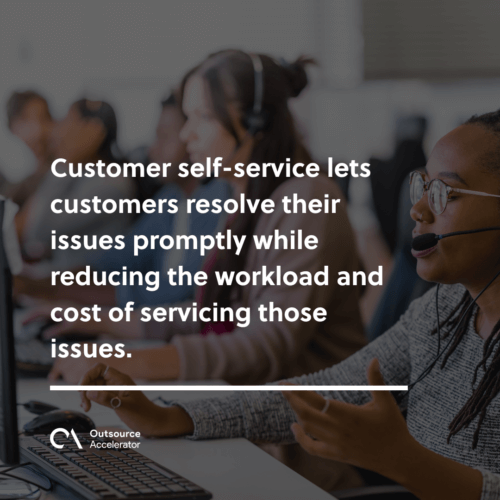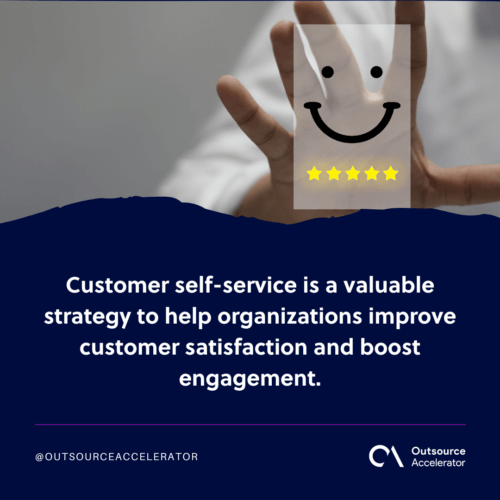Six best practices for customer self-service in the digital age

In our modern era of technology, customers can access information about product specifications through different types of self-service methods.
Most people believe that excellent customer service happens when a good representative is on the other line.
But the reality is that customers don’t always want to reach out for support. Most of them are natural problem solvers and what they need is just a little guide.
It’s not that they don’t trust the representatives to solve their concerns; some want to figure out things independently and get on with their day.
One more thing, customer service can be expensive, mainly when there are more people involved.
In some cases, it can be a real effort on the part of the customers too to explain their concerns to the agent on the other line.
That’s why over the past years, more companies have looked to technology that enables customers to self-serve and resolve their issues at a lower cost to the company.
Most business owners believe that customer self-service can be critical to delivering excellent support as long as the resources they provide are backed by human assistance.
Defining customer self-service
Customer self-service lets customers resolve their issues promptly while reducing the workload and cost of servicing those issues.
It is also the process of inbound customer interactions with the company to support their needs adequately.
It’s most commonly seen in customer support tools like FAQs and chatbots, where customers can usually log in and manage their accounts themselves.
Modern companies aim to serve substantial customer bases with relatively small teams. This is why self-service portals have had significant growth in tasks shift from company-driven to customer-driven.

How does customer self-service help consumers?
Customer self-service helps consumers in several ways.
Firstly, it allows them to access their accounts online. By doing this, they can make payments, check their balances, transfer money, and request a refund.
Customer self-service is all about giving consumers more and better control over their needs. It allows them to identify exactly which part of their concerns needs to be prioritized.
Many organizations are already tapping into customer self-service, but there are still many ways to jumpstart customer self-service in the organization.
How does customer self-service help the organization?
Answering customers’ questions are one of the main responsibilities of customer service representatives.
In the past, this has required customers to speak to someone over the phone or in person.
However, customer self-service features are expanding to offer consumers less expensive and time-consuming ways to interact with organizations.
These features also help companies create better customer service experiences and reduce costs by increasing customer support without adding more staff members.
Customer self-service is a valuable strategy to help organizations improve customer satisfaction and boost engagement.

Six best practices for customer self-service
Customer self-service is becoming increasingly popular to reduce support costs while boosting the overall level of service. However, self-service solutions are not as easy to implement.
Here are the best practices for customer self-service:
1. Use customer feedback to update your content
The frequency and quality of content updates play a crucial role in the success of any business.
This is because a site’s organic traffic and search engine rankings are often determined by how frequently it is updated.
To determine what works, you need objective data from customer feedback in the form of reviews, ratings, and comments.
For this reason, many website owners have been using customer feedback to determine when and how constantly their content should be updated.
2. Measure the effectiveness of your channel
Customer self-service channels often require different choices, such as in-touch vs. automated forms and in-person vs. over email.
Each channel needs to be measured and optimized to provide better performance.
To measure the effectiveness of these channels, you need to identify KPIs (key performance indicators) associated with each channel. It can give you insight into the impact it has on your customers and businesses.
3. Create product training for clients
Product training for self-service customers is an essential element of your product management process. They must know what they can do without going to a support agent.
Further, it can be a perfect solution when you want to improve productivity at customer self-service but also want them to understand how to override your product’s portal.
4. Provide flexible product features
The product features should support customers’ needs. It is also a fact that consumers have different levels of technical knowledge that vary greatly depending on their education level and age.
Therefore, making some walkthroughs regarding product features is essential to meet the needs of both new and exceptionally savvy users.
Customer self-service websites should also be capable of supporting multiple languages and geographical locations since many companies operate in several countries today.
5. Build a public forum
Building an online forum for customer self-service can turn customer complaints into opportunities to learn from them, respond to them and resolve their issues.
This will help you improve your customer self-service, increase conversion rates, build trust and credibility and reduce costs.
6. Know when not to self-serve
Self-service has several advantages for both customers and enterprises. However, it should be given at the right time, according to your CRM approach.
Human participation is occasionally the best course of action when addressing straightforward problems and client needs.
Why should you provide customer self-service?
The bottom line: Customer self-service can provide various benefits to your business.
When your company masters client self-service, customers may fix their problems without sending your staff an email or calling you to offer the service.
By including as much information as possible on your website, you may avoid hiring customer care professionals to address frequently requested queries.
As a result, you will ultimately save expenses, boost live agent efficiency, and enhance customer experience.







 Independent
Independent




